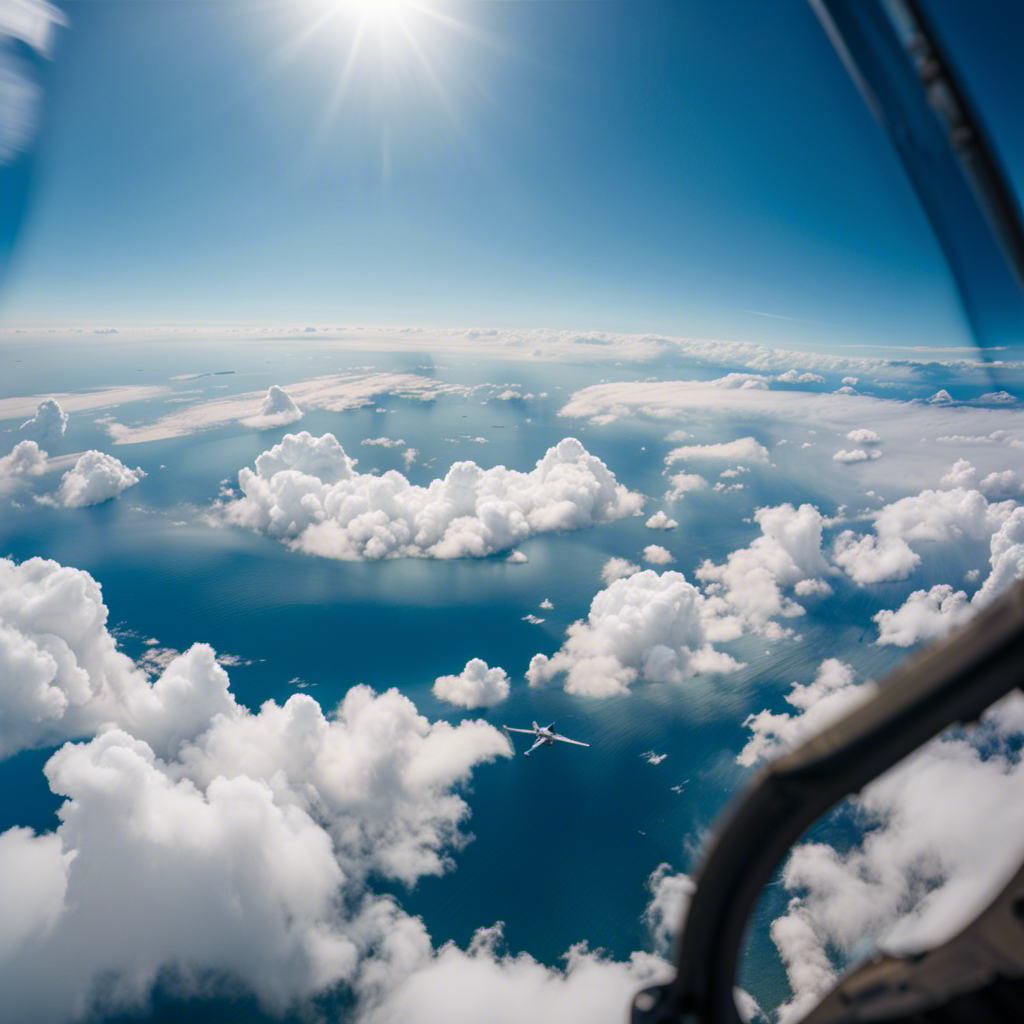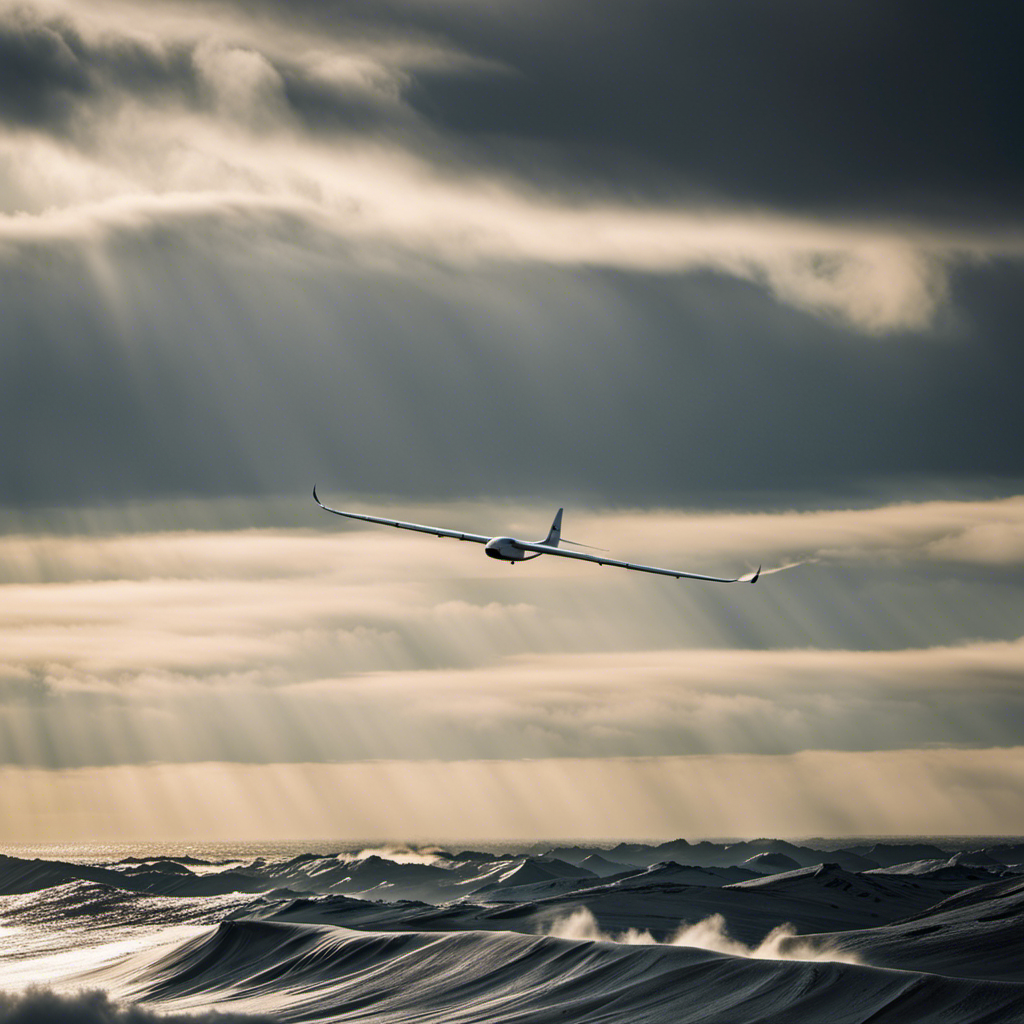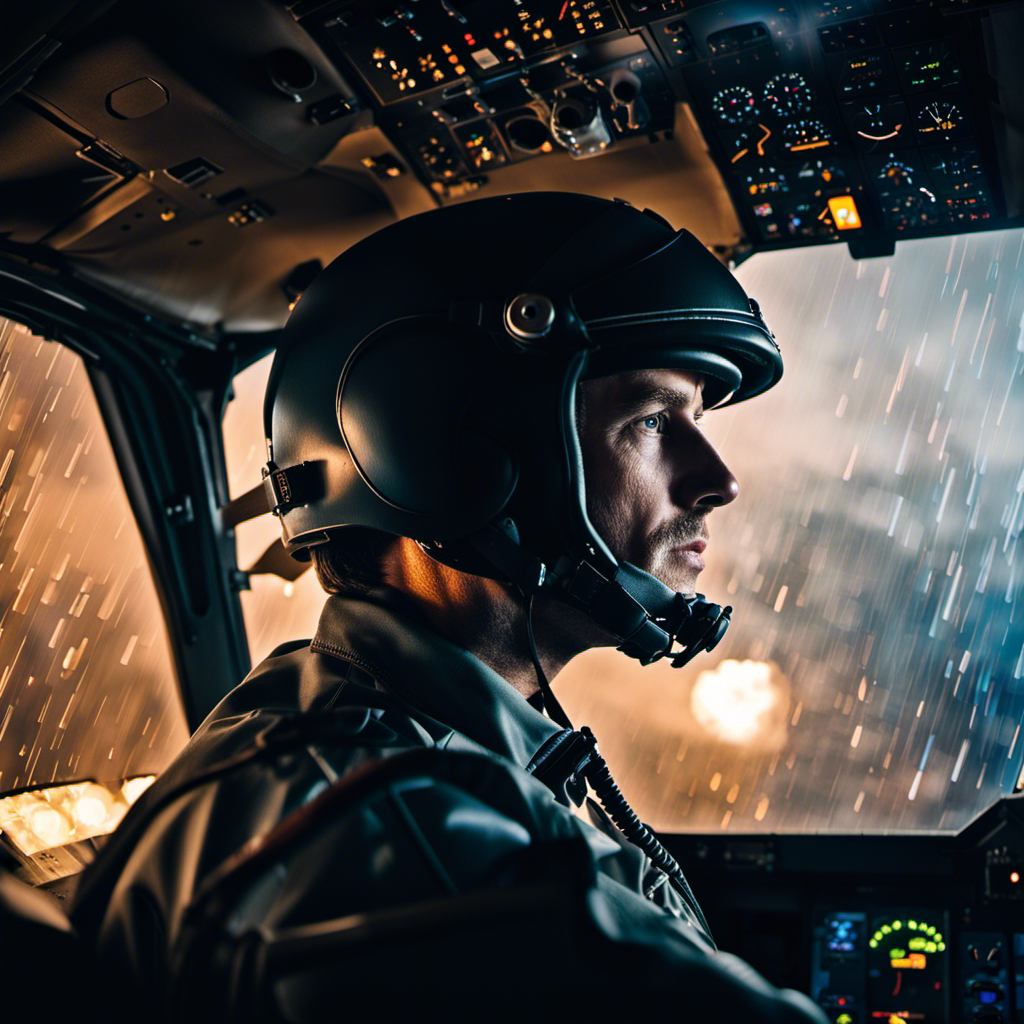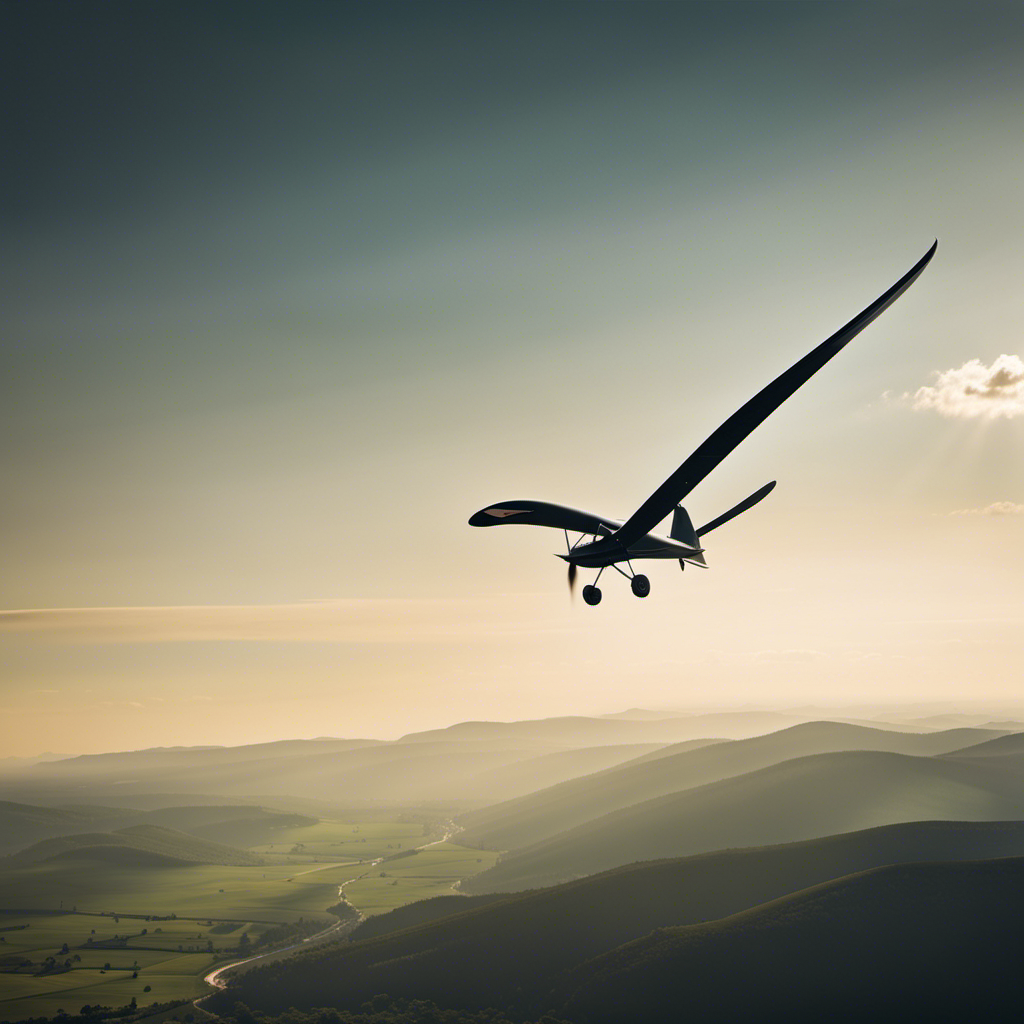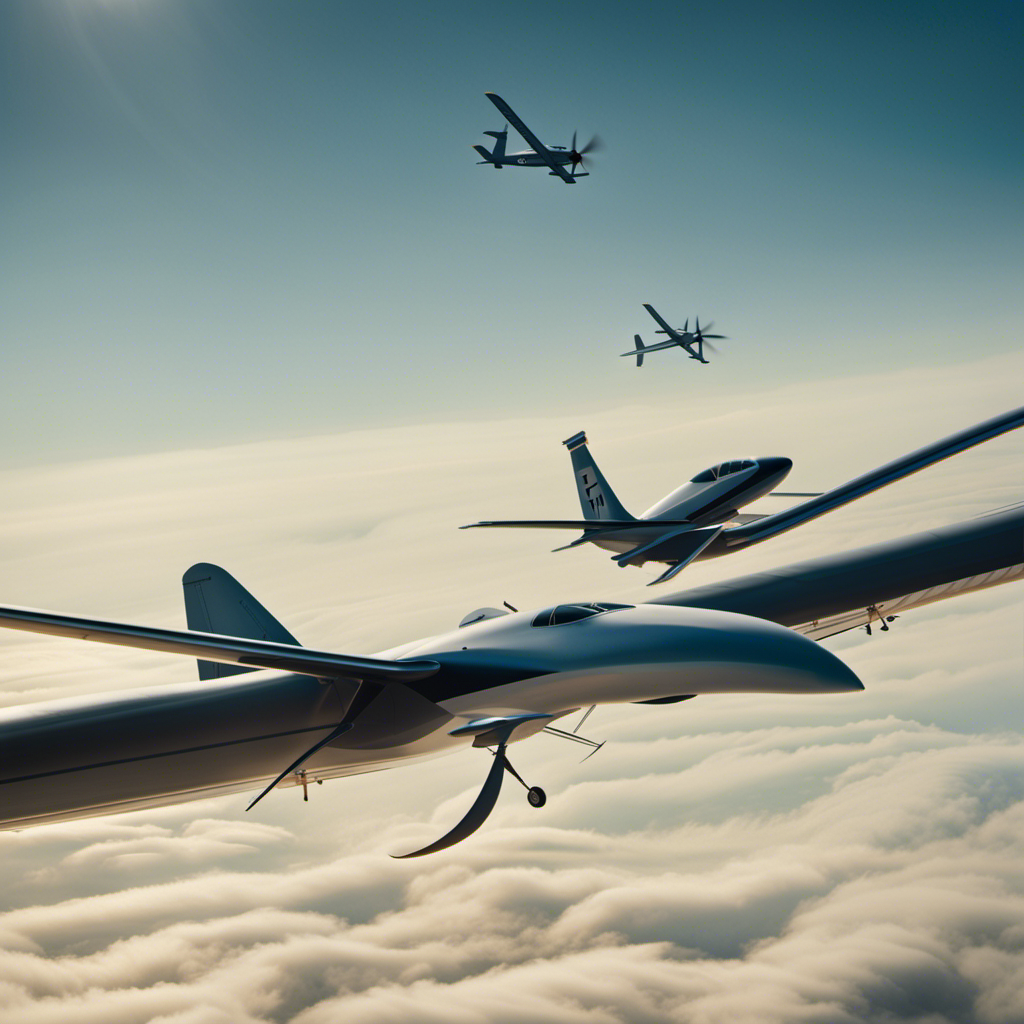As I soared through the sky, feeling the wind against my face, I realized that glider training involved more than just learning how to fly; it was about embracing a whole new way of life.
In this article, I will take you on a journey into the world of glider training, sharing the basic principles of flight, pre-flight procedures, and the exhilarating techniques of takeoff and landing.
Join me as we explore the art of gliding, from in-flight maneuvers to solo flights, and discover the joy of being part of a vibrant gliding community.
Key Takeaways
- A sturdy and reliable glider is necessary for glider training.
- Proper pre-flight inspection and awareness of weather conditions are essential for safety.
- Lift, glide ratio, and control inputs are key principles of flight to understand.
- Takeoff and landing techniques, including maintaining sync with the tow plane, are important skills to learn.
Introduction to Glider Training
Before you start your glider training, it’s important to have a thorough introduction to the basics. As someone who has been involved in glider training for many years, I can provide you with valuable insight and guidance.
Let’s begin by discussing the basic equipment you’ll need. Firstly, you’ll need a sturdy and reliable glider, which is essentially a lightweight aircraft without an engine. Additionally, you’ll require a parachute for safety purposes, as well as a helmet and proper clothing to protect yourself during the flight.
In terms of safety precautions, there are a few key measures you must always keep in mind. Firstly, it’s crucial to undergo a thorough pre-flight inspection of your glider, checking for any signs of damage or malfunction. Secondly, you must always be aware of the weather conditions before taking off, as strong winds or adverse weather can pose a significant risk. Lastly, it’s essential to follow proper communication protocols and maintain a safe distance from other aircraft in the vicinity.
Now that you have a solid understanding of the basic equipment and safety precautions, let’s dive into the next section: the fundamental principles of flight. Understanding these principles will lay a strong foundation for your glider training and enable you to become a skilled and confident pilot.
Basic Principles of Flight
Understanding lift and glide ratio is crucial for any aspiring glider pilot. Lift is the force that keeps the glider in the air, and the glide ratio determines how efficiently the glider can travel through the air.
Mastering control inputs is equally important, as they allow the pilot to maneuver the glider and maintain control during flight.
Understanding Lift and Glide Ratio
Once you grasp the concept of lift and glide ratio, you’ll be able to confidently navigate the skies in your glider. Understanding lift mechanics is crucial for maximizing glider performance.
Lift is generated by the wings as they move through the air. It is created by the difference in air pressure between the upper and lower surfaces of the wing. This upward force allows the glider to stay airborne.
Glide ratio, on the other hand, refers to the distance a glider can travel horizontally for every unit of altitude lost. A higher glide ratio means the glider can cover more ground while descending.
Mastering Control Inputs
To improve your flying skills, try mastering control inputs by practicing different maneuvers in your glider. As an experienced pilot, I can attest to the importance of understanding and implementing effective control techniques for optimal flight control. Here are three key control inputs to focus on:
-
Aileron Control: Use ailerons to roll the glider left or right. Practice coordinated turns to maintain stability and precision.
-
Elevator Control: Adjust the elevator to control pitch, which affects the glider’s altitude and climb/descent rate. Mastering elevator control is crucial for maintaining a stable glide.
-
Rudder Control: Utilize the rudder to control yaw, or the left and right movement of the glider’s nose. Proper use of the rudder enhances coordination and minimizes adverse yaw.
By honing these control techniques, you will become more proficient in maneuvering your glider.
Now, let’s delve into the next section and explore the essential pre-flight procedures.
Pre-Flight Procedures
Before taking to the skies, it’s crucial to ensure the glider’s airworthiness and assess the current weather conditions.
As a seasoned pilot, I have learned the importance of thoroughly checking the glider for any potential issues. This includes damaged control surfaces or worn-out components. Taking the time to inspect these areas can help prevent any unexpected problems during the flight.
In addition to checking the glider, I always take into account the weather conditions. This involves paying close attention to factors such as wind speed, temperature, and cloud cover. These elements can greatly affect the safety and performance of the flight.
Checking the Glider’s Airworthiness
Make sure you’re checking the glider’s airworthiness before your training session begins. As an experienced glider pilot, I know the importance of conducting a thorough inspection to ensure the safety and reliability of the aircraft. Here is a maintenance checklist that I always follow:
| Maintenance Checklist |
|---|
| 1. Check control surfaces for proper movement |
| 2. Inspect the canopy for any cracks or damage |
| 3. Verify that all instruments are functioning correctly |
| 4. Examine the landing gear for wear or loose components |
| 5. Inspect the wings and tail for any signs of damage or corrosion |
Assessing Weather Conditions
After ensuring the glider’s airworthiness, the next crucial step in glider training is assessing weather conditions.
As a glider pilot, I have learned the importance of understanding weather patterns and how they can affect our flight.
Assessing weather conditions involves studying meteorological reports, analyzing wind direction and speed, and observing cloud formations.
By carefully evaluating the weather, we can determine the safest time to fly and choose suitable flight routes.
It is essential to avoid adverse weather conditions such as strong winds, turbulence, or thunderstorms, which can be hazardous for glider operations.
By skillfully assessing weather conditions, we can plan our flights accordingly and maximize safety.
Now, let’s transition to the subsequent section about takeoff and landing techniques, which are vital aspects of glider training.
Takeoff and Landing Techniques
Launching with a tow rope is a crucial skill to master in glider flying. As a pilot, I have found that the key to a successful launch is maintaining a steady climb rate and staying in sync with the tow plane. By closely monitoring the tension on the tow rope and making small adjustments as needed, I am able to achieve a smooth and controlled takeoff.
When it comes to executing a safe landing, it is important to have a thorough understanding of the landing procedures and techniques specific to glider flying. This includes maintaining the correct approach speed, coordinating with air traffic control, and smoothly transitioning from descent to flare for a gentle touchdown.
Launching with a Tow Rope
When launching with a tow rope, you’ll need to keep your eyes on the tow plane at all times. This technique is essential for a successful and safe takeoff.
Here are four key points to remember when using a tow rope:
-
Maintain tension: As the tow plane accelerates, keep the rope taut to ensure a smooth and steady ascent.
-
Communicate: Use hand signals or radio communication to stay in sync with the tow pilot, ensuring a coordinated departure.
-
Stay centered: Position the glider directly behind the tow plane, maintaining a steady position to avoid any lateral movements.
-
Release smoothly: When reaching the desired altitude or upon pilot instruction, release the tow rope gently, ensuring a clean separation.
Mastering the tow rope technique is crucial for a successful launch. Once airborne, it’s time to focus on executing a safe landing, which requires precision and skill.
Executing a Safe Landing
To execute a safe landing, it’s important to maintain a steady approach and focus on your touchdown point. When it comes to executing a safe landing in a glider, there are a few key techniques to keep in mind.
First, ensure that you have established a proper glide path and are maintaining a consistent airspeed. This will help you maintain control and stability during the landing.
As you approach the touchdown point, be aware of any crosswinds and make the necessary adjustments to align with the runway. Keep your eyes fixed on the spot where you want to touch down and aim for a smooth, gentle descent.
By practicing these landing techniques, you will be able to execute safe landings consistently and with confidence.
Now, let’s move on to discussing in-flight maneuvers.
In-Flight Maneuvers
During flight, you’ll learn how to perform a variety of maneuvers in your glider training. Mastering these maneuvers will not only enhance your piloting skills but also allow you to fully explore the capabilities of your glider.
Here are some of the in-flight maneuvers you can expect to learn:
-
Thermalling Techniques:
Understanding how to find and utilize thermals is crucial for glider pilots. You will learn how to identify thermal sources such as rising air, clouds, and wind patterns. Mastering thermalling techniques will enable you to stay aloft for longer periods and increase your glider’s range. -
Aerobatic Maneuvers:
Gliders are capable of performing various aerobatic maneuvers, providing an exhilarating experience for pilots. You will learn basic aerobatic techniques like loops, rolls, and spins. These maneuvers not only test your skills but also allow you to fully appreciate the agility and maneuverability of your glider. -
Cross-Country Navigation:
Once you have mastered the basics, you will progress to cross-country flights. During these flights, you will learn how to plan routes, navigate using landmarks, and make strategic decisions to optimize your flight.
Understanding and practicing these maneuvers will prepare you for various scenarios in the air. In the next section, we will explore emergency procedures and safety measures that every glider pilot should be familiar with. Safety is paramount in glider training, and being prepared for unexpected situations is essential.
Emergency Procedures and Safety Measures
Remember, it’s important to familiarize yourself with emergency procedures and safety measures to ensure a safe and secure glider flying experience.
As a seasoned glider pilot, I understand the significance of being prepared for any unexpected situation that may arise during flight. Emergency procedures are a crucial part of our training, and they equip us with the skills needed to handle potential emergencies effectively. From practicing emergency landings to dealing with equipment malfunctions, we are taught to remain calm and take appropriate actions to ensure our safety.
Safety measures, on the other hand, are preventive measures that we adhere to during every flight. These measures include pre-flight inspections, ensuring proper use of safety equipment, and maintaining situational awareness throughout the flight. By following these procedures and measures, we can minimize the risks associated with glider flying and enjoy a worry-free experience.
Now, let’s move on to the next phase of your glider training: solo flight and progression.
Solo Flight and Progression
During my glider training, I learned about the importance of emergency procedures and safety measures in order to handle any unexpected situations that may arise. Now that I have a solid understanding of these procedures, I am ready to take the next step in my training: solo flight and progression.
Solo Flight Experience:
- Solo flight is an exhilarating experience where I will be solely responsible for flying the glider.
- This is a significant milestone that demonstrates my competence and readiness to fly on my own.
- It allows me to apply the skills and knowledge I have acquired during my training in a real-world scenario.
Skill Progression:
- As I gain more experience through solo flights, my skills will continue to improve.
- I will become more proficient in controlling the glider, executing maneuvers, and making decisions in different flight conditions.
- Each flight will contribute to my overall skill progression, building my confidence and expertise as a glider pilot.
Transition:
As I continue to develop my skills through solo flights and progression, I am now ready to explore advanced techniques and cross-country flying, taking my glider training to new heights.
Advanced Techniques and Cross-Country Flying
When it comes to advanced techniques and cross-country flying, two key points to focus on are reading wind patterns and cloud formations, as well as planning and executing long-distance flights.
Understanding wind patterns and cloud formations can help you identify areas of lift and sink, enabling you to make better decisions during your flight.
Additionally, effective planning and execution of long-distance flights involves careful consideration of weather conditions, airspace restrictions, and navigation techniques to ensure a safe and successful journey.
Reading Wind Patterns and Cloud Formations
Understanding wind patterns and cloud formations is crucial for successful glider training. As a seasoned glider pilot, I have learned the importance of reading wind speed and identifying cloud types. Here are three key aspects to consider when studying wind patterns and cloud formations:
-
Wind speed: By observing the movement of leaves, smoke, and dust, you can estimate the wind speed at different altitudes. This knowledge is vital for safe takeoffs and landings, as well as determining the best routes during a flight.
-
Cloud types: Different cloud formations indicate specific weather conditions. For example, cumulus clouds often signal thermals, which are essential for gaining altitude. Understanding cloud types can help you anticipate changes in wind direction and make informed decisions while flying.
-
Atmospheric stability: By observing cloud formations and their vertical development, you can gauge the stability of the atmosphere. Stable conditions are favorable for smooth flying, while unstable conditions may lead to turbulence and require caution.
Mastering the art of reading wind patterns and cloud formations is a fundamental skill for glider pilots. It sets the stage for planning and executing long-distance flights with confidence and precision.
Planning and Executing Long-Distance Flights
Mastering the art of reading wind patterns and cloud formations is crucial for glider pilots. It sets the stage for planning and executing long-distance flights with confidence and precision.
As an experienced pilot, I understand the importance of carefully considering planning logistics and managing fatigue during these flights. When embarking on a long-distance journey, it is essential to meticulously plan the route, taking into account the wind direction and speed at various altitudes. By analyzing cloud formations, I can anticipate areas of lift or sink, allowing me to optimize my flight path.
Additionally, managing fatigue is vital to ensure safety and efficiency. Proper rest and hydration before the flight, along with regular breaks during the journey, help maintain focus and alertness.
Glider Maintenance and Care
Take care of your glider by regularly inspecting the wings and tail for any signs of damage or wear. Glider maintenance and care are essential to ensure the longevity and optimal performance of your aircraft.
One important aspect of maintenance is keeping your glider clean. Regular cleaning helps remove dirt, debris, and insects that can affect the aerodynamics and overall performance of the glider. Additionally, cleaning the canopy and cockpit area not only improves visibility but also enhances the overall flying experience.
When it comes to glider storage, it is crucial to find a suitable location that provides protection from the elements. Ideally, a hangar or a covered storage area is the best option. This helps shield your glider from extreme weather conditions, such as rain, snow, or excessive heat, which can cause damage over time. If a hangar is not available, consider investing in a glider cover to provide some level of protection.
By properly cleaning and storing your glider, you can help prolong its lifespan and maintain its value. Regular inspections, cleaning, and proper storage are all part of being a responsible glider pilot. By taking these steps, you can enjoy the thrill of gliding for years to come.
Now, let’s move on to the next section and explore the exciting world of continued learning and enjoying the gliding community.
Continued Learning and Enjoying the Gliding Community
To fully immerse yourself in the gliding community, embrace the opportunities for continued learning and connect with fellow enthusiasts.
Gliding is not just a hobby, but a way of life. As a pilot, you never stop learning. There is always something new to discover, whether it’s a new technique, a different type of glider, or an advanced maneuver. Continued learning is essential to improving your skills and expanding your knowledge of the sport.
One of the best ways to continue learning is by participating in glider training programs. These programs offer advanced courses, workshops, and seminars that cover a wide range of topics, from navigation and meteorology to aerodynamics and safety procedures. By participating in these programs, you can stay up-to-date with the latest industry trends and developments.
In addition to formal training programs, connecting with fellow enthusiasts is another great way to learn and grow within the gliding community. Joining a gliding club or association allows you to meet experienced pilots who can share their expertise and insights. It also provides opportunities to engage in friendly competitions and fly with other pilots, which can be both exciting and educational.
By embracing the opportunities for continued learning and connecting with fellow enthusiasts, you can fully immerse yourself in the gliding community. This not only enhances your skills as a pilot but also fosters a sense of camaraderie and belonging within the gliding community.
Frequently Asked Questions
How long does it typically take to become a certified glider pilot?
Becoming a certified glider pilot typically takes around 3-6 months of training. Age restrictions vary, but most require pilots to be at least 14 years old. Good visual correction and physical fitness are important. Certified pilots can take others on flights.
Are there any age restrictions for glider training?
There are no age restrictions for glider training, as long as you meet the training requirements. These requirements typically include a minimum age of 14, good physical health, and the ability to pass a medical examination.
Can I fly a glider if I wear glasses or contact lenses?
Yes, you can fly a glider if you wear glasses or contact lenses. Many glider pilots wear corrective eyewear, and it doesn’t hinder their ability to fly. Just make sure your vision is clear and you’re comfortable.
Are there any physical fitness requirements for glider training?
Physical fitness requirements for glider training are minimal. As a pilot, I can tell you that being in good health is important, but you don’t need to be an athlete. Regular exercise and a healthy lifestyle are beneficial.
Can I take my friends or family members on a glider flight once I am certified?
Yes, once certified, I can take passengers on glider flights. However, safety considerations are crucial. Ensure your passengers are briefed on safety procedures and weight restrictions are followed to maintain a safe and enjoyable experience.
Conclusion
In conclusion, glider training is an exhilarating journey that will take you to new heights. From learning the basic principles of flight to mastering advanced techniques, you will soar through the skies with confidence and skill.
Just like a bird spreading its wings, you will experience the freedom and joy of gliding through the air. So buckle up and get ready to spread your wings and fly, because the gliding community is waiting to welcome you with open arms.
Remember, the sky’s the limit, so don’t be afraid to reach for the stars. Happy gliding!
With a heart that soars as high as the skies, Aria, affectionately known as “Skylark,” is the driving force behind Soaring Skyways. Her journey into the gliding world began as a young dreamer gazing up at the soaring birds, yearning to experience the weightlessness and freedom they embodied. With years of experience both in the cockpit and behind the scenes, Aria’s commitment to the gliding community is unwavering.
